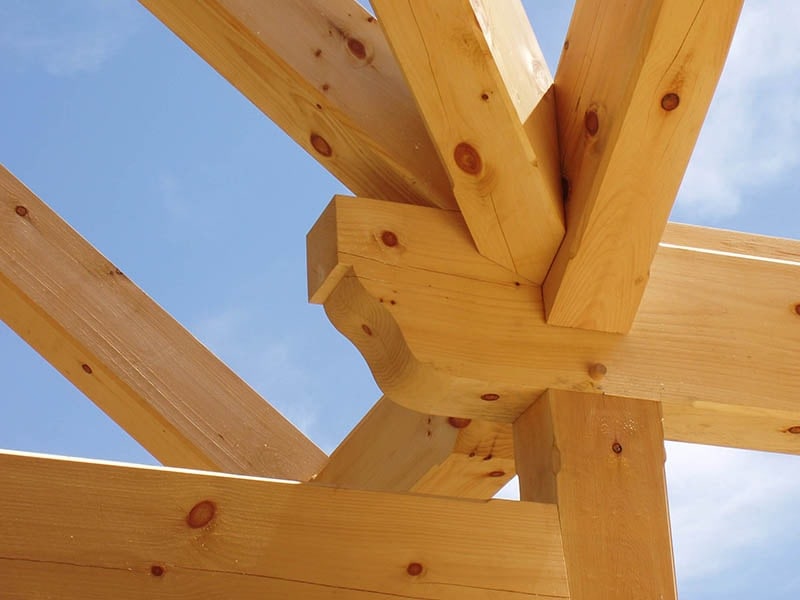There are many species of wood that may be used in a timber frame building, though the choice of wood to use for your project is not always simple when you’re trying to stay on a budget. We use a variety of different materials in our frames; typically our clients prefer Eastern White Pine, Hemlock, or West Coast Douglas Fir. These are all good choices, but for very different reasons. We also employ maple and yellow birch in our hardwood “free tenons,” or “splines,” as we call them. And white oak is the material of choice for our wooden pegs to secure our joinery; these renewable hardwoods are harvested and milled right here in New Hampshire.
Eastern White Pine is far and above the most popular choice for timbers here in the Northeast. One hundred years ago most of New England was recovering from decades of clear-cutting, but our rich soil and abundant moisture has allowed for rapid regrowth of the Great Northern Forest. Typically, softwoods grow faster and are the first to mature in a developing forest, and as a result you will notice that many of our forests, especially at high altitudes and northern latitudes, are predominantly spruce, pine, and fir.
Eastern White Pine is a particularly good wood for timber framing, as it is easy to work with (being a softwood), but it is “well behaved” when properly treated, and is quite strong for its weight. It doesn’t deflect or twist excessively, like oak, and for most applications it can easily span as much as 20 feet. Boxed heart Eastern White Pine describes a timber that has been cut in such a way that the core of the tree remains centered along the entire length of the timber. This type of timber is much more stable than pine that is “free of heart.” In addition, pine tends to stay in place with only minimal restraint, either as a material stored in a lumber shed or in situ in your new home. Once it has been secured it will remain straight and true.
All softwoods have a tendency to check, although not as much as many hardwoods. A “check” is a split running parallel to the grain that results from drying and shrinking of the wood fibers. Some species, like Hemlock and even Douglas Fir, can fall victim to “shake,” which is a form of checking that runs around one of the growth rings and can, in its worst form, cause an entire corner of a timber to shear completely off of the core. Pine has a stronger cross-grain fiber that helps prevent this type of checking. When a boxed heart pine timber checks, the checks can’t penetrate the center of the timber and don’t run along the growth rings, so the longitudinal wood fibers remain intact and the timber isn’t weakened. Slow drying also helps prevent excessive checking in all woods.
We are often asked about the use of Free of Heart Center (FOHC) Pine, and we do not recommend its use, due to limited availability and its instability without the heart to keep it from twisting and warping. Douglas Fir, on the other hand, should be used in FOHC since it will shrink and check much more than pine. Old Growth Douglas Fir trees are big enough that timbers can be cut out of them free of heart, and, as is the nature of old growth timber, the growth rings are very dense and uniform since the tree grew slowly over many centuries. Therefore it is less susceptible to checking or “shake” than faster growth material. Unfortunately, Old Growth Douglas Fir is not a realistically renewable resource, and, since it has to be shipped across a continent, it is not a sustainable choice. Therefore, it should not be considered a “green” material in the northeast. Although it can be harvested in a “standing dead” form, which saves the cutting of old growth forest, it remains difficult to ship to the northeast. One option for sustainable northeastern Douglas Fir timbers is to purchase locally reclaimed Douglas Fir from a timber salvage company. Douglas Fir remains popular due to its lovely golden color, availability in an almost “clear” or very small knot, and its much higher strength than eastern softwoods.
Of course, there are many other wood varieties from which to choose. Each type of wood has its advantages and disadvantages. Factors to consider are:
Availability
Sustainability
Cost
Strength and suitability in a frame
If you have a specific wood in mind or would like to discuss options please contact us. We would be happy to answer your questions.
Author: Paul Freeman
